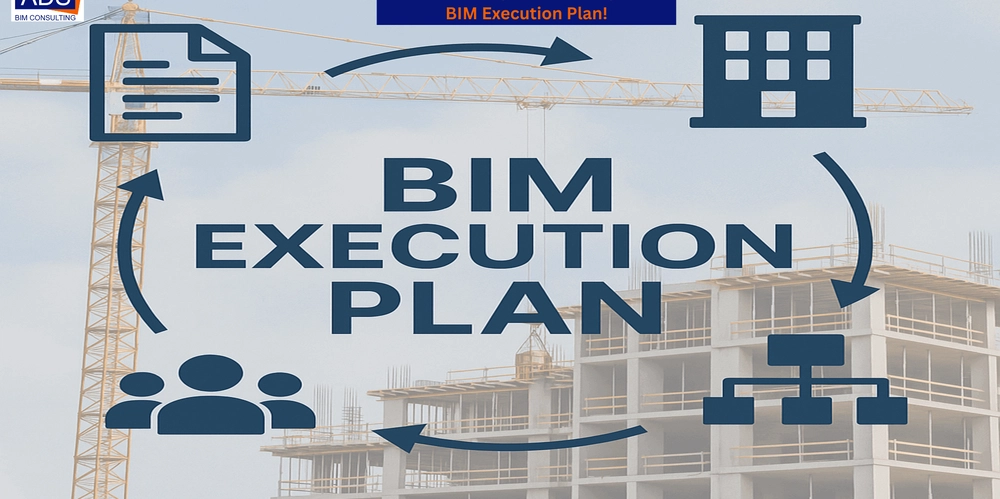How a BIM Execution Plan Drives Project Success in the Construction Industry
Introduction: Why a BIM Execution Plan is Crucial for Construction Projects The construction industry has seen significant advancements in technology over the years, and one of the most influential of these is Building Information Modeling (BIM). BIM is transforming how projects are designed, planned, and executed. However, to fully leverage the potential of BIM, a BIM Execution Plan (BEP) is essential. A BIM Execution Plan is not just a document; it is the backbone of successful project implementation, ensuring seamless collaboration, minimizing errors, and improving the overall quality of construction projects. In this blog, we will explore the importance of a BIM Execution Plan and how it ensures smooth project execution, reduces risks, and improves collaboration among stakeholders. What is a BIM Execution Plan (BEP)? A BIM Execution Plan (BEP) is a detailed document that outlines the approach to implementing BIM on a construction project. It includes information on the roles and responsibilities of each team member, the software and tools to be used, collaboration protocols, and specific modeling standards. The purpose of the BEP is to ensure that everyone involved in the project is aligned and has a clear understanding of the BIM processes from the outset. The BIM Execution Plan helps manage the entire project lifecycle, from design to construction, by setting expectations, defining workflows, and ensuring all team members are working within a common framework. Key Benefits of a BIM Execution Plan The BIM Execution Plan provides numerous benefits that help improve the overall efficiency, cost-effectiveness, and quality of a construction project. Here are a few of the key advantages: Improved Communication and Collaboration The BEP ensures that all project stakeholders, including architects, engineers, contractors, and subcontractors, have a clear understanding of their roles and responsibilities. This fosters better communication and promotes collaboration throughout the project. Minimized Errors and Rework One of the main benefits of a BIM Execution Plan is that it minimizes errors and rework. By setting clear standards and procedures upfront, the BEP helps reduce costly mistakes, leading to significant time and cost savings. Enhanced Project Visibility A BIM Execution Plan provides a transparent view of the entire project, allowing all stakeholders to access real-time information and make informed decisions. This transparency is key to ensuring the project is progressing as planned. Cost Control The BEP helps ensure that the project is completed within budget by streamlining processes, identifying potential cost-saving opportunities, and reducing inefficiencies. Risk Management A comprehensive BEP helps identify potential risks early on, allowing the team to develop mitigation strategies before issues arise, reducing the likelihood of project delays. Key Components of a BIM Execution Plan To ensure that the BIM Execution Plan is comprehensive and effective, it should include several key components: Project Information: Overview of the project, including objectives, timeline, and deliverables. BIM Goals and Objectives: Specific goals for using BIM on the project, such as improving coordination, reducing costs, or increasing efficiency. Roles and Responsibilities: Clear roles for each team member, including project managers, architects, engineers, and contractors. Software and Tools: The BIM software and tools to be used, such as Revit, Navisworks, or BIM 360, ensuring compatibility across the team. Collaboration Guidelines: Detailed guidelines for file sharing, communication, and coordination among project stakeholders. Modeling Requirements: Specifications for the Level of Detail (LOD) of models at different project stages. Quality Control: Protocols for ensuring the accuracy and quality of the BIM models throughout the project lifecycle. Training and Support: Plans for training team members on BIM tools and processes to ensure proper implementation. How to Develop a BIM Execution Plan Creating an effective BIM Execution Plan requires a structured approach and collaboration from all project stakeholders. Here’s a step-by-step guide to help you get started: Define the Project Scope: Gather input from all stakeholders to understand the project requirements, objectives, and challenges. Set BIM Goals: Establish clear, project-specific BIM goals, such as improving collaboration or reducing costs. Select BIM Standards and Protocols: Choose the appropriate BIM standards (such as ISO 19650) to guide the project. Assign Roles and Responsibilities: Define who will be responsible for each aspect of BIM implementation, from modeling to coordination. Choose BIM Software: Select the BIM software and tools that will be used throughout the project, ensuring they are compatible and efficient. Establish Collaboration Processes: Set up communication channels and file-sharing protoco

Introduction: Why a BIM Execution Plan is Crucial for Construction Projects
The construction industry has seen significant advancements in technology over the years, and one of the most influential of these is Building Information Modeling (BIM). BIM is transforming how projects are designed, planned, and executed. However, to fully leverage the potential of BIM, a BIM Execution Plan (BEP) is essential.
A BIM Execution Plan is not just a document; it is the backbone of successful project implementation, ensuring seamless collaboration, minimizing errors, and improving the overall quality of construction projects. In this blog, we will explore the importance of a BIM Execution Plan and how it ensures smooth project execution, reduces risks, and improves collaboration among stakeholders.
What is a BIM Execution Plan (BEP)?
A BIM Execution Plan (BEP) is a detailed document that outlines the approach to implementing BIM on a construction project. It includes information on the roles and responsibilities of each team member, the software and tools to be used, collaboration protocols, and specific modeling standards. The purpose of the BEP is to ensure that everyone involved in the project is aligned and has a clear understanding of the BIM processes from the outset.
The BIM Execution Plan helps manage the entire project lifecycle, from design to construction, by setting expectations, defining workflows, and ensuring all team members are working within a common framework.
Key Benefits of a BIM Execution Plan
The BIM Execution Plan provides numerous benefits that help improve the overall efficiency, cost-effectiveness, and quality of a construction project. Here are a few of the key advantages:
Improved Communication and Collaboration
The BEP ensures that all project stakeholders, including architects, engineers, contractors, and subcontractors, have a clear understanding of their roles and responsibilities. This fosters better communication and promotes collaboration throughout the project.
Minimized Errors and Rework
One of the main benefits of a BIM Execution Plan is that it minimizes errors and rework. By setting clear standards and procedures upfront, the BEP helps reduce costly mistakes, leading to significant time and cost savings.
Enhanced Project Visibility
A BIM Execution Plan provides a transparent view of the entire project, allowing all stakeholders to access real-time information and make informed decisions. This transparency is key to ensuring the project is progressing as planned.
Cost Control
The BEP helps ensure that the project is completed within budget by streamlining processes, identifying potential cost-saving opportunities, and reducing inefficiencies.
Risk Management
A comprehensive BEP helps identify potential risks early on, allowing the team to develop mitigation strategies before issues arise, reducing the likelihood of project delays.
Key Components of a BIM Execution Plan
To ensure that the BIM Execution Plan is comprehensive and effective, it should include several key components:
Project Information: Overview of the project, including objectives, timeline, and deliverables.
BIM Goals and Objectives: Specific goals for using BIM on the project, such as improving coordination, reducing costs, or increasing efficiency.
Roles and Responsibilities: Clear roles for each team member, including project managers, architects, engineers, and contractors.
Software and Tools: The BIM software and tools to be used, such as Revit, Navisworks, or BIM 360, ensuring compatibility across the team.
Collaboration Guidelines: Detailed guidelines for file sharing, communication, and coordination among project stakeholders.
Modeling Requirements: Specifications for the Level of Detail (LOD) of models at different project stages.
Quality Control: Protocols for ensuring the accuracy and quality of the BIM models throughout the project lifecycle.
Training and Support: Plans for training team members on BIM tools and processes to ensure proper implementation.
How to Develop a BIM Execution Plan
Creating an effective BIM Execution Plan requires a structured approach and collaboration from all project stakeholders. Here’s a step-by-step guide to help you get started:
Define the Project Scope: Gather input from all stakeholders to understand the project requirements, objectives, and challenges.
Set BIM Goals: Establish clear, project-specific BIM goals, such as improving collaboration or reducing costs.
Select BIM Standards and Protocols: Choose the appropriate BIM standards (such as ISO 19650) to guide the project.
Assign Roles and Responsibilities: Define who will be responsible for each aspect of BIM implementation, from modeling to coordination.
Choose BIM Software: Select the BIM software and tools that will be used throughout the project, ensuring they are compatible and efficient.
Establish Collaboration Processes: Set up communication channels and file-sharing protocols to facilitate collaboration.
Implement Quality Control Procedures: Develop a system for checking the quality of BIM models and ensuring they meet project standards.
Frequently Asked Questions (FAQs)
Q1: What is the purpose of a BIM Execution Plan?
A BIM Execution Plan provides a structured approach to implementing BIM on a construction project, ensuring clear communication, collaboration, and alignment among all project stakeholders.
Q2: Who is responsible for creating a BIM Execution Plan?
Typically, the BIM Manager or BIM Coordinator is responsible for creating the BIM Execution Plan. However, it should be developed collaboratively with input from all project stakeholders.
Q3: How does a BIM Execution Plan reduce project risks?
By outlining clear roles, responsibilities, and procedures, a BIM Execution Plan helps identify potential risks early in the project. This allows for the development of mitigation strategies, reducing the likelihood of costly delays and errors.
Q4: Can the BIM Execution Plan be changed during the project?
Yes, the BIM Execution Plan should be a living document. If changes occur during the project, the plan should be updated to reflect the new requirements and ensure continued alignment.
Q5: What are the benefits of implementing a BIM Execution Plan?
The benefits include improved collaboration, reduced errors and rework, enhanced project visibility, better cost control, and more effective risk management.
Why Choose ADS BIM for Your BIM Execution Plan?
At ADS BIM, we specialize in creating customized BIM Execution Plans that ensure your project runs smoothly from start to finish. Our team of experts works with you to define your BIM goals, select the right tools, and set up a framework for collaboration that maximizes efficiency and minimizes risks.
Contact ADS BIM today to learn how we can help you create a successful BIM Execution Plan that drives project success and enhances overall project delivery.
BIMExecutionPlan #BuildingInformationModeling #ConstructionManagement #ProjectSuccess #BIMImplementation #BIMGoals #BIMStandards #BIMConsulting #ConstructionEfficiency #BIMForConstruction
Internal Links:
Explore our BIM Services for construction projects [here](https://www.adsbim.com/bim-services/).
Learn about BIM Consulting and how we can support your team [here](https://www.adsbim.com/bim-consulting-services/).
Discover Our BIM Experience and how we’ve helped transform projects [here](https://www.adsbim.com/bim-projects/).
Are you ready to enhance your construction project with an effective BIM Execution Plan? Contact ADS BIM today and let us help you streamline processes, minimize risks, and achieve success. Let’s build smarter, together!











































































































































































![[The AI Show Episode 142]: ChatGPT’s New Image Generator, Studio Ghibli Craze and Backlash, Gemini 2.5, OpenAI Academy, 4o Updates, Vibe Marketing & xAI Acquires X](https://www.marketingaiinstitute.com/hubfs/ep%20142%20cover.png)




























































































































![[DEALS] The Premium Learn to Code Certification Bundle (97% off) & Other Deals Up To 98% Off – Offers End Soon!](https://www.javacodegeeks.com/wp-content/uploads/2012/12/jcg-logo.jpg)


![From drop-out to software architect with Jason Lengstorf [Podcast #167]](https://cdn.hashnode.com/res/hashnode/image/upload/v1743796461357/f3d19cd7-e6f5-4d7c-8bfc-eb974bc8da68.png?#)








































































































.png?#)

































_Christophe_Coat_Alamy.jpg?#)
 (1).webp?#)





































































































![Apple Considers Delaying Smart Home Hub Until 2026 [Gurman]](https://www.iclarified.com/images/news/96946/96946/96946-640.jpg)
![iPhone 17 Pro Won't Feature Two-Toned Back [Gurman]](https://www.iclarified.com/images/news/96944/96944/96944-640.jpg)
![Tariffs Threaten Apple's $999 iPhone Price Point in the U.S. [Gurman]](https://www.iclarified.com/images/news/96943/96943/96943-640.jpg)




































































































































